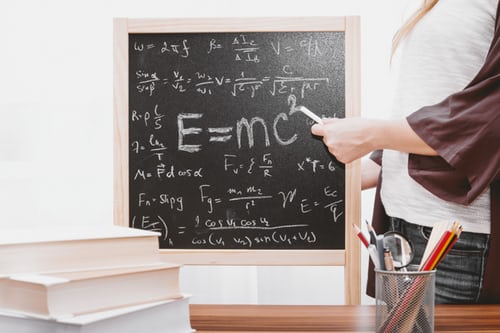
Our Most Famous Mathematical Equations
There is nothing scientific about my ranking system; I am featuring the equations that seem to have permeated the mainstream.
Everyday Equations
In terms of fame, there are three big equations, derived from Einstein, Pythagoras, and Newton. We are all exposed to these regularly through mainstream media and/or through secondary education. While Schrödinger’s Equation is not that well-known by the layperson, most of us have heard of the associated Schrödinger’s cat thought experiment which helps to explain the principles of quantum mechanics.
1. E = mc² (Mass-Energy Equivalence)
This equation has even made it onto T-shirts as some kind of nerdy fashion statement, so most people are aware of it, even if they don’t know what it means. Proposed by Albert Einstein, perhaps the most famous scientist in history, it’s no surprise this E = mc² is the most well-known, but one of the least understandable to the layman. The answer? In short, Einstein showed that a small amount of mass can create a heck of a lot of energy – as in the amount you find in in stars – and it paved the way to the nuclear age.
2. Pythagorean Theorem (c² = a² + b²)
We all did this at school so it’s one’s pretty famous and is attributed to the ancient Greek mathematician Pythagoras. It states that for any triangle, the square of the length of the hypotenuse (the side opposite the right angle) is equal to the sum of the squares of the lengths of the other two sides. This theorem forms the basis of Euclidean geometry which is used in architecture and navigation.
3. Newton’s 3 Laws of Motion
Formulated by Sir Isaac Newton, and popularised by the scientist’s apple falling on head Eureka moment, this equation describes the relationship between force (F), mass (m), and acceleration (a). The first states that an object’s motion will not change unless acted upon by a force (Inertia). The second law states that the force exerted by an object is equal to its mass times its acceleration (Force). And the third is that when two moving objects they exert equal and opposite forces on each other (Action and Reaction).
4. Schrödinger’s Equation (Quantum Mechanics)
Erwin Schrödinger’s Equation describes how the quantum state of a physical system evolves over time, incorporating the wave-particle duality of matter, which refers to the fact that matter at one moment acts like a wave and yet at another moment acts like matter. This equation has been popularised by the famously related Schrödinger’s Cat thought experiment which was designed to simplify quantum mechanics and which is now referenced in many science fiction works.
If you are interested in studying Maths as a subject, Oxford Open Learning offer you the chance to do so at a variety of levels, listed below. You can also Contact Us here.